When improving your home’s thermal performance, the envelope—the walls, roof, and cladding—plays a crucial role. One of the smartest exterior upgrades available today is Thermowood cladding, a thermally modified timber known for its outstanding stability, insulation benefits, and low maintenance needs.
Let’s explore how this natural material can help you achieve better comfort, lower energy bills, and a sleek architectural look—all at once.
🔥 What Is Thermowood?
Thermowood is softwood (usually pine or spruce) that has been heat-treated in a controlled, oxygen-free environment. The high-temperature process permanently changes the wood’s structure, reducing its moisture absorption and improving dimensional stability.
This modification not only extends the wood’s life but also makes it more resistant to warping, swelling, and decay—perfect for energy-efficient façades that need to remain airtight over time.
👉 See the full range here: Thermowood Cladding Collection
🌿 How Thermowood Enhances Energy Performance
- Less Thermal Movement:Stable boards prevent gaps that cause heat loss and air leakage.
- Improved Envelope Durability:Fewer maintenance cycles and less water absorption mean insulation layers stay dry and effective.
- Natural Insulator:Wood has low thermal conductivity; combining Thermowood with ventilated cavity systems reduces bridging and helps regulate wall temperature.
- Lightweight Design:Perfect for retrofit projects without heavy structural reinforcement.
🧱 Profile Options for Efficient Façades
Depending on your design and insulation setup, you can choose among several profile types:
- Rainscreen (20×68 mm or 26×68 mm):Allows excellent ventilation and quick drying.
- Shadow Gap (19×117 mm or 19×140 mm):Creates modern linear detailing while keeping the wall breathable.
- Triple Shadow Gap (32×140 mm):Ideal for bold, architectural façades.
👉 Explore individual profiles:
🛠️ Installation & Detailing Tips
To maximise both aesthetics and performance:
- Install over a treated batten systemwith a ventilated cavity.
- Include insect meshat base and eaves to maintain airflow.
- Use stainless-steel fixingsand pre-drill to avoid splitting.
- Combine with breathable membranes and continuous insulation for optimum results.
For energy-focused projects, proper detailing around windows and junctions ensures a continuous thermal line, preventing cold spots.
🎨 Finishing & Maintenance
Thermowood can be left untreated to weather to a soft silver tone or coated for colour retention. Because of its low moisture content, finishes adhere better and last longer than on standard timber.
- For natural looks: leave unfinished.
- For tone control: apply UV-resistant oils.
- For bold colours: use high-quality breathable stains.
Most homeowners only need to refresh the coating every few years, keeping upkeep simple.
🌎 Sustainability Benefits
- Made from FSC-certified European pine/spruce.
- Processed using heat and steam—no toxic chemicals.
- Long service life reduces material waste.
With its durability and low environmental impact, Thermowood fits perfectly within modern low-carbon design principles.
⚡ Conclusion
Thermowood cladding proves that energy efficiency and natural beauty can coexist. Its superior stability, breathability, and insulating properties make it an ideal upgrade for anyone seeking a comfortable, low-maintenance, and sustainable home exterior.
Explore your options through the Thermowood Cladding range and discover how simple design choices can dramatically improve your home’s energy performance.
Related posts
Categories
Recent Posts
Advertisment


